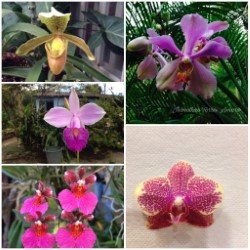Jhonathan Torres Amaro
The fascinating botanical family of orchids is very varied. Capture the interest of people. In it there are plants with an enigmatic beauty and present infrequent features in the vegetable kingdom. You can observe different forms of growth, types of vegetative organs, sizes and flowers. In the wild they can live on trees, rocks and on the ground. Some are climbers. It is normal to have difficulty knowing precisely if a plant is an orchid when you come across one of these wonders of nature.
Below is a brief description of the nine main characteristics by which you will recognize a plant as belonging to the family of orchids. Some of them can be found in other plant families, but the set only occurs between the orchids:
1. Showy flowers with extremely modified parts. The petals and sepals can have very different forms. They may be enlarged or dwarfed. The coloration is variable (Figure 1).
 )
)
Figure 1. Various types of flowers present in orchids. In order: Paphiopedilum, Arundina, Oncidium, Vanda and Phalaenopsis.
2. Flowers with lip. There are always three petals. One of them very modified and completely different from the others. It usually stands out for its color. It may be larger or smaller than the other two. It is responsible for protecting the reproductive organs (Figure 2).
 )

 )
)
Figure 2. Two different types of lip: reduced and enlarged.
3. The flowers, when viewed frontally, can only be divided by a plane of symmetry. They are called zigomorphic flowers. This characteristic is common in other families, which leads to confusion (Figure 3).
 )
)
Figure 3. Typical orchid flower (Phalaenopsis). Its single plane of symmetry is indicated.
4. The reproductive organs are fused in the structure called the column. It is an organ of the flower in which the style and stigma (female organs) are united with the anthers (male organs). It presents a female region (stigma) and apart, a male region with pollen grains grouped in masses. It is the most distinctive of orchids (Figure 4).
 )
)
Figure 4. Orchid flowers in which the column can be observed.
5. The pollen grains are grouped in masses called pollinia. Pollen grains do not look like dust. They are grouped into more or less solid units. They are located near the end of the column. They have adaptations that allow them to be carried by insects (Figure 5).
 )
)
Figure 5. Orchid pollinea.
6. The fruit is a capsule. It is formed by the fusion of six carpels of the ovary. It has an internal cavity that contains tiny seeds (Figure 6).
 )

 )
)
Figure 6. Capsular fruit of an orchid with seeds in sight.
7. The seeds are tiny. Its length usually ranges between 0.15 and 6 mm. Each fruit can contain between 500,000 and 4,000,000 seeds. They have a thin seminal cover formed by a layer of cells. They are very light, which helps to be dispersed by the wind (Figure 6).
8. Simplified embryos. It presents an extreme simplification. It lacks the parts that are commonly found in the embryos of other plants. No cotyledon is observed, no leaves in formation, no radicle, no growth points. It lacks food reserves. Germination depends on a symbiotic relationship with environmental fungi.
9. Orchids are always herbs. They can vary in size, from a few centimeters to several meters. But always herbs. They do not present wood.
Now you can feel more secure when you face a plant that you suspect is an orchid. Comparing the previous characteristics you will be able to identify it.
Nota: All the images of the article have been elaborated by the author.
Information Sources:
Fich. C. 1972. Orchids for the house. The complete Book of House Plants. Elsevier-Hutton. New York. Sheehan, T. 1980. Recent Advances in botany, propagation and physiology of orchids. Horticultural Reviews 5: 279-315. Thunder Bay. 2002. Botanicas Orchids. Random House Australia. Australia. 608 p. Tyson, R. 1962. Home Orchid Growing. Second Edition. Van Nostrand. U.S.A.
Congratulations @jhotoram! You have completed the following achievement on Steemit and have been rewarded with new badge(s) :
Click on the badge to view your Board of Honor.
If you no longer want to receive notifications, reply to this comment with the word
STOPDownvoting a post can decrease pending rewards and make it less visible. Common reasons:
Submit